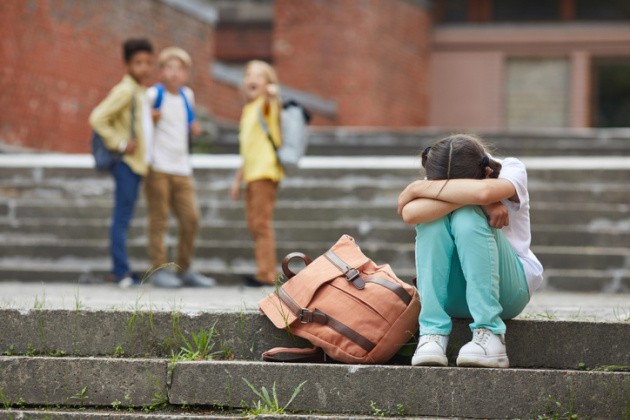What’s the Difference Between Teasing, Bullying and Social Aggression? An Expert Weighs In

In this “Dear Highlights” episode, Christine French Cully, Highlight’s Editor in Chief, and Hillary Bates, Director of Purpose and Impact, welcome back parenting educator Jennifer Miller to talk about social aggression, exclusion and gossiping in elementary school. Being mean at times, and being on the receiving end of meanness, is common in childhood. In a world that isn’t always kind, how can we help children lean into the best versions of themselves? They discuss how adults can employ curiosity and compassion to guide kids through mean moments.
Christine starts by saying, “…in these divided times when civil discourse seems to be increasingly rare, we see more social aggression in adults, and as we often say, our kids are always watching.” Hillary agrees and is grateful for this conversation because social aggression is something more universal that systematic bullying. They both discuss how children and adults experience moments they wish they could take back, when they’ve said something hurtful or had something hurtful said to them.
Christine shares a part of a letter from Hank, who wrote Highlights as 7-year-old, and she says it’s stuck with her for years. Hank confided:
Sometimes my friends run away from me on the playground, and that makes me sad.
A recent letter from Gloria, who writes to Highlights often, details a time when she witnessed social aggression in her class:
…This boy in my class was bullying a girl in my class and kept calling her ugly. She was too afraid to tell him to stop. She tried to do it, but he just kept saying mean things to her. When the teacher leaves the room, the girl hides under the table and the boy starts getting bossy and told her to go sit down. He even tried to call the teacher to get her in trouble. When he called her names, she quickly went to sit back down. No one was brave enough to tell the teacher what happened, but I did. Every single day, I felt nervous thinking he was going to bully her again. I was going to tell you months ago, but I just forgot.
Hillary remarks on how Gloria remembered these interactions months later because these are “the deepest learning and most memorable things that happen to kids in childhood.”
“Sometimes my friends run away from me on the playground, and that makes me sad.” -Hank, age 7
Christine starts the conversation with Jennifer by focusing on adults. She reflects on how every adult has a moment from their childhood where they felt like they were on the receiving end of mean behavior, and on the flipside, where they regret being mean themselves. However, she notes, it’s common for grown-ups to talk about how someone was mean to them, rather than a time when they were mean. She asks Jennifer why that is.
Jennifer explains, “Emotion seals in memory.” The more intense the emotion, the bigger the memory. A painful interaction is going to be something that sticks with someone. Jennifer goes on to say adults usually see their younger behavior as more innocent, so they might not realize their mean moments when they’re looking back.
To frame the discussion, Christine explains they’ll be focusing on mean behaviors, ones that wouldn’t be classically defined as bullying. She asks Jennifer to clarify the differences between teasing, bullying and social aggression. Jennifer defines the three and outlines the differences.
- Teasing is subjective. It could be silly jokes at someone else’s expense, where person being teased takes it lightheartedly. Teasing, however, can feel like exclusion or rejection. It depends on how it’s interpreted by the teaser and the teasee.
- Social aggression is different from teasing because it’s the intent to cause emotional harm. It can be hard to identify because of its various forms, like spreading rumors or gossiping, excluding other children, using body language to subtly hurt someone or using explicit words to be mean.
- Bullying is a series of actions that typically increase over time and centers around powers. A child who’s showing bullying behavior typically starts with small actions that grow as they feel like they’re gaining power. It can be extremely painful and traumatic for children who are on the receiving end of bullying.
Jennifer stresses that children who exhibit bullying behavior have been bullied, either from adults in their lives or from other children. They’re seeking power and don’t know how to constructively grow it.
Christine thanks Jennifer for clarifying these behaviors since “bullying” can be a catch-all term for mean behavior.
Hillary notes that bullying has a power, purpose and plan, whereas friendships are where power exchange is happening fluidly. Kids can experiment with forms of social aggression within their friendships. She asks Jennifer about the common ways in which elementary school kids experiment with social aggression.
Jennifer explains that social aggression in elementary school can take many forms. It could be using direct mean words, which might be more damaging in elementary school, where there’s a classroom audience. It could be about excluding kids from play, games or birthday parties. It could happen in social media or in person.
Because social aggression can be subtle, she notes, it might be difficult for a child to pinpoint why they’re feeling pain. Behaviors like negative body language might be hard to explain.
“If our conversation tends toward judging, criticizing, blaming, aggression, competition, then how can we notice and begin to turn around that conversation so that we’re modeling the kind of values we want our children to grow into?”
If a parent suspects something is going on, Hillary wonders what questions can be asked to understand what their child is feeling and unravel whether they’re having a conflict with a friend.
Jennifer stresses that it’s important to tread lightly when making these inquiries. It can be frustrating for children to express and figure out what’s happening when they’re experiencing social aggression because of its subtle nature. Having patience and compassion can drive the conversation forward. She suggests asking about what was going on at the time when they were hurt. For example, she says if they were on the playground, a grown-up could ask questions like, “What was going on? What were you playing? Who was playing together? When did you start feeling unsafe?”
It's also important, she continues, not to judge the other child because it’s hard to know the exact circumstances causing the meanness. It can harm friendships “if we immediately judge children in their sphere,” Jennifer explains. Keep the dialogue open and approach it with compassion for your child, but also with curiosity about what’s going on with their friend.
Jennifer shares an incident with her own son. He was hearing mean words on the playground from a friend and was surprised and hurt by it. She patiently talked with her son and found out that his friend’s parents were going through a divorce. She says it was very revealing because she was able to help her son make a connection between the mean words and how he was hurting because of what was happening at home.
Christine had a similar experience with her son, and it was easy to show grace when you know what’s going on outside the immediate situation. She also notes that social aggression can come from different influences and causes. It can just be normal behavior as kids try to figure out who they are and where they fit in.
Jennifer agrees and says, “it’s important for schools to teach how to act kindly, to include rather than exclude [and] to relate to one another in positive ways.” She points out that these social skills will be tested. “Children make mistakes as part of their learning, but they’re testing everything related to friendships and in-groups and out-groups, so they really need models and specific practice with, for example, reaching out to a child who’s brand new [to the school] and including them.” If children aren’t taught compassionate social interaction, then exclusion will happen, she notes.
There have been reports since the start of the pandemic about an increase in social aggression from children, Hillary shares, particularly at the kindergarten level since they haven’t been in a lot of peer-group environments over the last few years. She asks Jennifer how to help children who’ve not been in social settings for a while.
Jennifer has reviewed some of the studies related to the uptick in social aggression in young kids, and she notes they all confirmed this increase in “externalizing behaviors”—the pain you’re feeling inside “comes out and sprays on someone else.”
There can be many reasons for this behavior now, such as parental distress and stress at home. Children will internalize this stress, and when they have an opportunity to be with their peers and feel more agency, the social aggression can come out.
To help relieve the internalized stress and help decease the incidence of aggression, Jennifer says parents “need to be intentional in educating and re-educating children on social skills, including setting boundaries [physical and emotional] and being kind.” She notes that grown-ups can help kids develop friendships by discussing the qualities that make a good friend. It’s also important to educate kids on how to let others know when they’re stepping over the line and acting in angry or abusive ways.
It's tricky, she acknowledges, for adults to implement these social skills, so it’s even trickier for kids. However, because of the pandemic, where kids have spent time in isolation, it’s particularly important to focus on their social-emotional skills building, so they’re getting “extra rehearsal” for how to be in a relationship with others.
Hillary loves the idea of having a rehearsal to practice these skills. So much focus has been placed on learning loss, she says, but kids who write to Highlights are concerned about friendships and making friends at this point in elementary school. She hopes parents and educators are as energized to help kids with their social loss as much as they are concerned with their learning loss.
Hillary asks what kinds of life lessons or social-emotional learning can come from experiencing social aggression. She inquires about whether parents should intercede, both when a child is the recipient of mean behavior and when they’re the aggressor.
Jennifer says it’s important to jump in any time a child goes through a painful experience. Listening to their feelings, helping them name their feeling and articulating their feelings back to them to show compassion helps teach social-emotional growth. It’s also an opportunity, she notes, to ask questions about a friendship like, “What was the other person feeling? Why were they so angry? Were they angry with other children? Were they angry throughout the day?” She says children are learning the skill of empathy, and they can misinterpret what other children’s words or actions are about.
After discussing the situation, she says, you can practice empathy with your child and have a rehearsal for how to address the negative behavior and set boundaries if necessary. They can practice what they will say the next time they see their friend or the next time they experience mean words, which can be empowering. It could be as simple as, “Stop. That hurts.”
Hillary points out it’s more likely parents will hear from their child when they’re having social aggression happen to them, not when they’re perpetrating it. In those instances, she says, it’s likely parents will find out from other parents or from their school that their child is being mean. She asks how parents can coach their kids to reign in their own inner meanness.
Jennifer explains that if there are red flags or if they have conflicts with their siblings, it’s time to talk to them. Working on the sibling relationship is an important part of teaching compassion and empathy. Parents can ask themselves, “Are they being kind and do they resolve conflict without being mean?” Fostering compassion and empathy can alleviate a parent from having to mediate sibling conflicts.
She then points out the one thing that’s so important to do but harder focus on, which is our own self-awareness about our friendships and relationships. When we’re talking with or around our children, do we talk in ways that blame? Do we judge and criticize when we’re disagreeing with others. Or do we offer open space for differing opinions? Do we show kindness when we’re disagreeing? Jennifer explains, “Our own modeling matters in a huge way…and the best way to work on that is to ask, ‘how am I relating to my friends?’”
For social aggression in the public sphere, Christine notes it might be common to view aggression as strength or toughness. She asks whether adults are contributing to an increase in social aggression among children because of this perception and whether we’re contributing to the idea that it’s acceptable behavior, especially for leaders.
Jennifer explains that it depends on the person and family, but in general, yes. Our national discourse has been aggressive, and, in many instances, it doesn’t promote dialogue or debates that are healthy and constructive. A lot of what’s in the media is framed in a win-lose stance, and our children are learning from that.
Being aware and creating bubbles of collaboration in our households can create a ripple effect in neighborhoods and schools, Jennifer notes, and we can demonstrate how to dialogue and disagree with an open mind and an open heart and accept that differences are necessary and important so we can learn.
Christine ends with the question she asks every guest. Children are the world’s most important people, and if we really as a society believe that, what would we do differently to help our children become their best selves?
Jennifer responds, “The thing that jumps out at me immediately is our own self-awareness and that we take that mantle very seriously. We [need to] listen to ourselves, turn the mirror on ourselves when we’re having our dinner conversations about social issues, about issues in the news, about stories of neighbors or peers in our school community. How do we talk about people? And are we articulating compassion? Are we articulating empathy? Are we articulating curiosity and an interest in differences and an interest in learning? If our conversation tends toward judging, criticizing, blaming, aggression, competition, then how can we notice and begin to turn around that conversation so that we’re modeling the kind of values we want our children to grow into.”
Our goal of the‘Dear Highlights’ podcast is is to elevate the voices of children from these letters and help parents raise kids to be curious, creative, caring, and confident.









